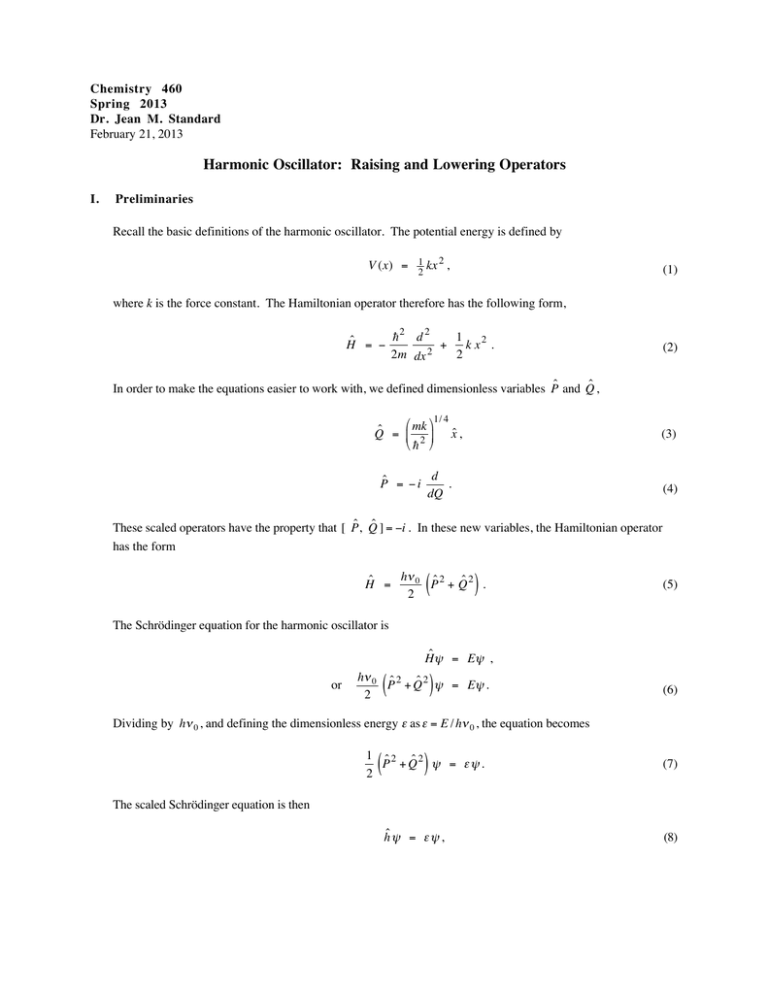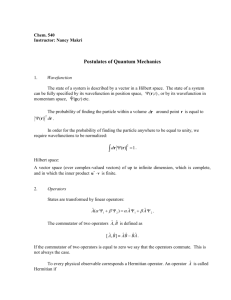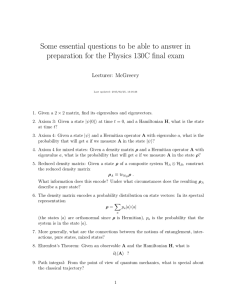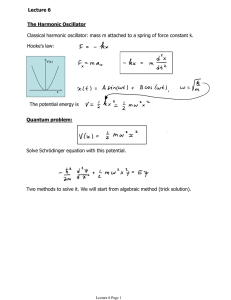Harmonic Oscillator: Raising and Lowering Operators
advertisement

Chemistry 460 Spring 2013 Dr. Jean M. Standard February 21, 2013 Harmonic Oscillator: Raising and Lowering Operators I. Preliminaries Recall the basic definitions of the harmonic oscillator. The potential energy is defined by V (x) = 1 2 kx 2 , (1) where k is the force constant. The Hamiltonian operator therefore has the following form, € 2 d 2 1 Hˆ = − + k x2 . 2 2m dx 2 (2) In order to make the equations easier to work with, we defined dimensionless variables Pˆ and Qˆ , € ⎛ mk ⎞1/ 4 Qˆ = ⎜ 2 ⎟ xˆ , ⎝ ⎠ € € € (3) d Pˆ = − i . dQ (4) These scaled operators have the property that [ Pˆ , Qˆ ] = −i . In these new variables, the Hamiltonian operator has the form € hν 0 ˆ 2 ˆ 2 Hˆ = P +Q . 2 ( € ) (5) The Schrödinger equation for the harmonic oscillator is € Hˆ ψ = Eψ , or hν 0 ˆ 2 ˆ 2 P + Q ψ = Eψ . 2 ( ) (6) Dividing by hν 0 , and defining the dimensionless energy ε as ε = E / hν 0 , the equation becomes € 1 ˆ2 ˆ2 P + Q ψ = εψ . 2€ ( € ) (7) The scaled Schrödinger equation is then € hˆ ψ = ε ψ , € (8) 2 where the scaled Hamiltonian operator hˆ is given by 1 ˆ2 hˆ = P + Qˆ 2 . 2 ( € II. ) (9) Definitions of Raising and Lowering Operators € We now define two new operators, called raising and lowering operators, for reasons that will become apparent later on. Define 1 ˆ P − i Qˆ , 2 ( a = ) (10) 1 2 a+ = (Pˆ + i Qˆ ) . + The operator a is called the lowering operator, and the operator a is called the raising operator (the "hats" have + € been left off these operators for convenience). Using the definitions of a and a , it is easy to show that the + commutator is a, a = 1. € € [ III. ] Scaled Hamiltonian Operator € + The scaled Hamiltonian operator hˆ for the harmonic oscillator may be expressed in terms of a and a in a number of different ways. + + Form 1. First, consider € the expression aa + a a . Using the definitions, we get 1 ˆ 1 ˆ aa + + a + a = P − i Qˆ Pˆ + i Qˆ + P + i Qˆ Pˆ − i Qˆ 2 2 € = Pˆ 2 + Qˆ 2 . ( )( ) ( )( € ) (11) Thus, we can write the scaled Hamiltonian operator as € 1 hˆ = a a+ + a+a . 2 ( ) (12) + Form 2. Next, consider simply the € expression a a . Again, substituting the definitions of the operators, the expression can be written 1 ˆ € a+a = P + i Qˆ Pˆ − i Qˆ 2 1 ˆ2 ˆ2 i ˆ ˆ = P +Q − P, Q 2 2 1 = hˆ − . 2 € ( )( ) ( ) [ ] (13) 3 So, the scaled Hamiltonian operator can also be written in the form: 1 hˆ = a + a + . 2 (14) Form 3. Starting from form 2, we can use € the commutator to express the scaled Hamiltonian operator in one + more way. This form can also be derived in a similar fashion to form 2 by starting with the expression a a . From form 2 of the scaled Hamiltonian operator, 1 hˆ = a + a + . 2 € (15) Using the definition of the commutator, € [a, a+ ] = 1, or a a + − a + a = 1. (16) € + Solving for a a yields € a + a = a a + − 1. (17) € Substituting this into the expression for hˆ gives € 1 hˆ = a a + − . 2 € IV. More on Commutators (18) € + The commutators of a and a with hˆ are useful expressions which are easily evaluated. + A. Commutator of a with hˆ € € Using form 2 of the Hamiltonian operator, € € a + , hˆ [ ] ⎡ 1 ⎤ = ⎢ a + , a + a + ⎥ ⎣ 2 ⎦ [ = a+ , a+a ] ⎡ 1 ⎤ + ⎢ a + , ⎥ ⎣ 2 ⎦ The second commutator is zero since the commutator of any operator with a constant is zero. € (19) 4 Using the identity [ Aˆ , Bˆ Cˆ ] = Bˆ Aˆ , Cˆ [ ] + [ Aˆ , Bˆ ] Cˆ , (20) + [a+ , a+ ] a . (21) [a+ , Hˆ ] = [a+ , a+ a] = a + [ a + , a] € [ + The commutator of any operator with itself is zero, so the second term above is zero. Since a, a + − 1 . Therefore, we know that a , a = € [ ] = 1, ] [a+ , hˆ] € B. Commutator of a with hˆ € = − a+ . (22) € In a similar manner, the commutator of a and hˆ can be evaluated to yield € a, hˆ = a . € [ ] (23) + V. Proof that a is a raising operator € + Many of the relations derived in previous sections are useful in demonstrating that a is a raising operator. We start€with the scaled Schrödinger equation, hˆψ = ε ψ . € (24) + Apply a to both sides, € a + hˆ ψ = ε a + ψ . (25) € Use the commutator, € [ a+ , hˆ] = − a+ a + hˆ − hˆ a + = − a + . (26) a + hˆ = hˆ a + − a + . (27) + Solving for a hˆ , € € Inserting this relation into Eq. (25) yields, € € ( hˆ a + ) − a+ ψ = ε a+ ψ . (28) 5 Moving the second term on the left to the right side, hˆ a + ψ = a + ψ + ε a + ψ ( ) hˆ a + ψ ( ) = (ε + 1) a + ψ . (29) + Eq. (29) is the Schrödinger Equation with the eigenfunction a ψ and eigenvalue ε + 1. It is easy to show by + analogy that applying a to the€Schrödinger Equation n times yields the equation ⎛ hˆ ⎜ a + ⎝ ( ) € n ⎞ ψ ⎟€ = ⎠ (ε n€ ⎞ ⎛ + n) ⎜ a + ψ ⎟ . ⎝ ⎠ ( ) (30) This procedure yields a whole series of eigenvalues and eigenfunctions of the Schrödinger Equation: € Eigenfunction (a ) + € Eigenvalue ψ ε + n 3 (a ) ψ (a ) ψ + € n + ε+3 2 € a+ ψ ψ € ε+2 ε +1 ε € € The set of eigenfunctions and eigenvalues is sometimes€called the "ladder of solutions" of the Schrödinger € Equation for the harmonic oscillator. The raising and lowering operators are therefore sometimes referred to as € € "ladder operators". + If we write the Schrödinger Equation for the nth state, ψ n , we have hˆ ψ n = ε ψ n . Applying a to this equation as previously described yields ( hˆ € a +ψ n ) ( ) = (ε n € + 1) a +ψ n . € (31) + Thus, we see that the function a ψ n is an eigenfunction of the Schrödinger Equation with eigenvalue ε n + 1 . The eigenvalue has been raised€by 1; therefore, it corresponds to the eigenvalue for the n+1st state, ε n+1 = ε n + 1. Therefore, the eigenfunction a + ψ n must be proportional to the eigenfunction for the n+1st state, € € € a + ψ n = c+ ψ n+1 , € where the coefficient c+ is yet to be determined. € € (32) 6 VI. Proof that a is a lowering operator Again, we start with the scaled Schrödinger equation, hˆ ψ = ε ψ . (33) a hˆ ψ = ε a ψ . (34) Apply a to both sides, € Using the commutator, € [ a, hˆ] = a a hˆ − hˆ a = a . (35) Solving for a hˆ , € a hˆ = hˆ a + a . (36) € Substituting this relation into Eq. (34), € ( hˆ a + a) ψ = ε aψ . (37) Moving the second term on the left to the right side, € hˆ a ψ = − a ψ + ε a ψ hˆ ( a ψ ) = (ε − 1) ( a ψ ) . (38) Eq. (38) is the Schrödinger Equation with the eigenfunction a ψ and eigenvalue ε − 1. It can be shown that applying a to the Schrödinger Equation n times yields the equation € ⎛ ⎞ hˆ ⎜ a + ψ ⎟ €= ⎝ ⎠ ( ) (ε ⎛ n €⎞⎟ − n) ⎜ ( a) ψ . ⎝ ⎠ A ladder of solutions of the Schrödinger Equation is generated by this procedure: € Eigenfunction ψ aψ a2 ψ € € € a3ψ € € € an ψ Eigenvalue ε ε −1 ε−2 ε−3 ε−n € € € € (39) 7 Writing the Schrödinger Equation for the nth state, ψ n , we have hˆ ψ n = ε n ψ n . Applying a to this equation as before yields hˆ ( a ψ n ) €= (ε n − 1) ( a ψ n ) . € (40) The function a ψ n is therefore an eigenfunction of the Schrödinger Equation with eigenvalue ε n − 1 . The eigenvalue has been lowered by 1; therefore, it corresponds to the eigenvalue for the n–1st state, € ε n−1 = ε n − 1. Therefore, the eigenfunction a ψ n must be proportional to the eigenfunction for the n–1st state, € € € a ψ n = c− ψ n−1 , € (41) where the coefficient c− must be determined. € + VII. Non-Hermitian character of a and a € + The operators a and a are not Hermitian. Recall that an operator Aˆ is Hermitian if € f Aˆ g = Aˆ f g . € € (42) By starting with the left side of this relation and considering the operator to be the lowering operator a, we can show that it does not equal the right side € and therefore a is not Hermitian. The left side of the Hermitian equation for the operator a is given by f a g . (43) Using the definition of the operator a, we have f a g € = = Pˆ − i Qˆ g 1 2 f 1 2 f Pˆ g − i 2 f Qˆ g . (44) ˆ The operators Pˆ and Q are Hermitian (this can be proved using a method similar to the one that was used in Problem Set 1). Thus, € from the definition of a Hermitian operator € € and f Pˆ g = Pˆ f g , f Qˆ g = Qˆ f g . (45) Substituting these expressions into Eq. (44) yields € € f a g = 1 2 f Pˆ g − = 1 2 Pˆ f g − i 2 i 2 f Qˆ g Qˆ f g . (46) 8 Since i* = –i, the second term in Eq. (46) can be rewritten as = 1 2 f a g = f a g Pˆ f g + 1 2 i Qˆ f g . (47) Recombining the two terms on the right, € Since by definition a + = € 1 2 (Pˆ + i Qˆ ) f 1 2 (48) g . (Pˆ + i Qˆ ) , the equation above can be written f a g a+ f g . = (49) € Since f a g ≠ a f g , the operator a is NOT Hermitian. € VIII. Determination of the coefficients c+ and c− € In order to make effective use of the raising and lowering operators, it is necessary to determine the constants c+ and c− in the expressions € € a + ψ n = c+ ψ n+1 a ψ n = c− ψ n−1 . € A. € (50) Determination of c− To determine c− , we start with € consideration of the integral a ψn a ψn € . (51) € Using the equation above, this integral can be rewritten as € a ψn a ψn c− ψ n−1 c− ψ n−1 = = c−* c− a ψn a ψn c−* c− = ψ n−1 ψ n−1 , (52) assuming that the eigenfunctions are normalized. € We can also write Eq. (51) in another way, using the non-Hermitian character of the raising and lowering operators; that is, that f a g = a+ f g . (53) Eq. (51) can therefore be rewritten as € a ψn a ψn € = a+a ψn ψn . (54) 9 Next, the relation a + a = hˆ − 1 2 can be substituted, a ψn a ψn = € = a ψn a ψn (hˆ − 12 ) ψn ψn (ε n − 12 ) ψn ψn = εn − 1 2 . * From Eq. (52), the left side of the above equation is also equal to c− c− ; therefore, € c−* c− = ε n − 12 . € 1 Finally, since the scaled eigenvalue ε n equals n + 2 , we have (55) (56) € c−* c− = n . (57) € * Choosing c− to be real allows c − = c − . This then leads to € c− = n , (58) € € € and therefore the equation for the lowering operator becomes € a ψn = n ψ n−1 . (59) B. Determination of c+ € The coefficient c+ is determined in a similar fashion. This time, we start with consideration of the integral a+ ψn a+ ψn € . (60) € This integral can be rewritten using the definition of the raising operator, € a+ ψn a+ ψn = c+ ψ n+1 c+ ψ n+1 = c++ c+ + + a ψn a ψn = c+* c+ ψ n+1 ψ n+1 . (61) Using the non-Hermitian character of the raising and lowering operators, the integral given in Eq. (60) can be written as € a+ ψn a+ ψn € = a a+ ψn ψn . (62) 10 Next, the relation a a + = hˆ + 1 2 can be substituted, a + ψ n a +ψ n € = = a+ ψn a+ ψn (hˆ + 12 ) ψn ψn (ε n + 12 ) ψn ψn = εn + 1 2 . (63) * From Eq. (61), the left side of the above equation is also equal to c+ c+ ; therefore, € c+* c+ = ε n + 12 =€n + 12 + 1 2 c+* c+ = n + 1. (64) * Choosing c+ to be real allows c + = c + . This then leads to € c+ = n + 1 , (65) € € and therefore the equation for the raising operator becomes € € a+ ψn = n + 1 ψ n+1 . (66)



